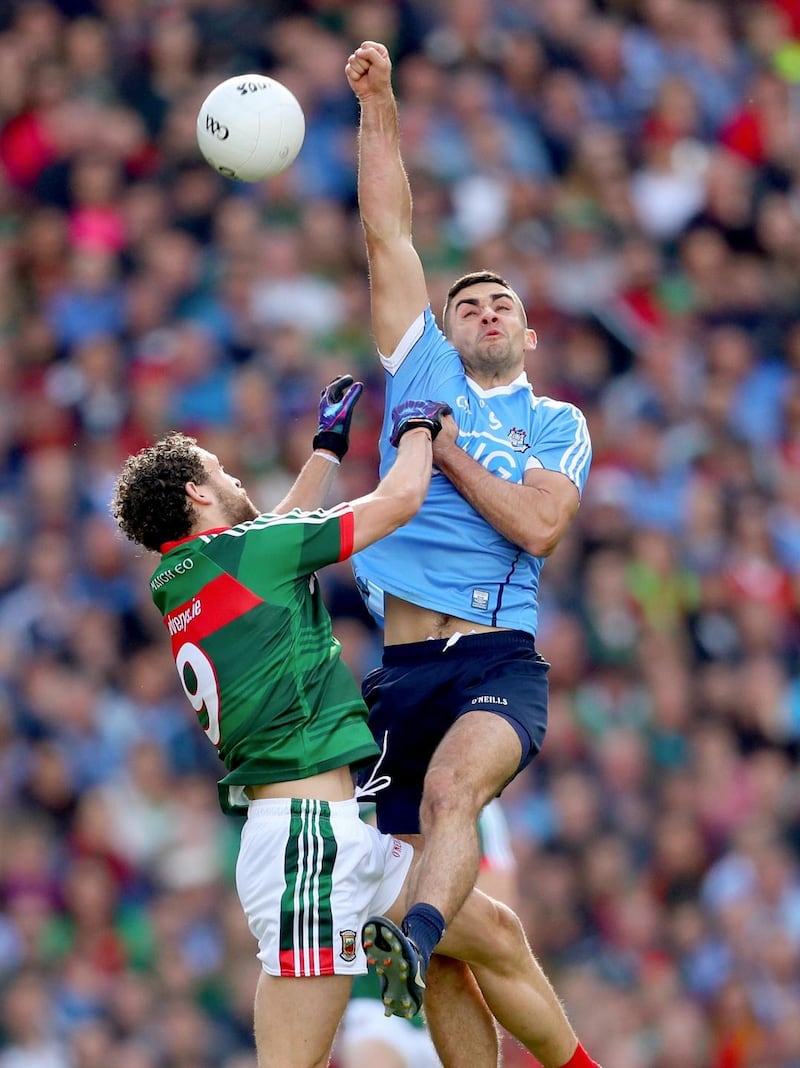With hip surgery specialists claiming that 80 per cent of their patients are GAA players, it’s clear that the majority of gaelic footballers and hurlers believe going under the knife is the best solution to their chronic hip pain.
However, some players, including Footballer of the Year nominee James McCarthy, have been experimenting with another alternative.
Mobility training is far more prevalent in the US and in Canada in particular, but its principles have now made their way to Ireland. The belief is that improved mobility and movement can teach athletes to utilise the full potential of their joints and muscles – including their hips – before exerting intense and regular pressure upon them. They also believe their methods can be an alternative to quick-fix treatments and surgery.
"At the moment I have nine intercounty players, and when they initially came in they all lacked control of their hip capsule," explains Brian O'Loughlin, who along with Rob Gallagher runs Movement 101 in Swords, Dublin.
“Straight away it becomes clear, and it’s quite simple really, they have never trained their hips. Yet they do movements that require control of their hips: for example squats, deadlifts, kicking, jumping. But they’ve never actually trained their hips to do these things, and as a result everything around the hips has to fire and compensate. When they are training and adding more muscle on top of this, injury will occur. So, they go to a physio, do some rehab, and then go back and the cycle starts all over again.”
Modern living
O’Loughlin believes that modern living means that as human beings we do not move as we should or could. So when the demands of “sport, a human invention that we have just made up and we’re not necessarily made to do” are thrown in on top of that, players failing to train for the basic and additional movements required in their sport will inevitably become injured.
“Be a good human first and then you’ll be a good athlete. Any sport needs you to be specialised in that sport, whatever it may be. So golf, GAA, any sport, it makes you move in a certain way. And if you haven’t got the correct control of your joints to make those movements constantly, then your other joints will have to compensate. If you compensate for a certain amount of time a day, a week, a year, 10 years – it’s all individual – you’re just much more likely to get injured. Eventually your body will decide it can’t do this anymore.”
Both O’Loughlin and Gallagher got involved in fitness due to their own injury problems. O’Loughlin, now 31, has a personal trainer qualification, a degree in Health and Physical Activity, and is a Functional Range Conditioning (FRC) mobility specialist. Functional Range Conditioning is a trademarked system of mobility and joint control training developed in Canada and focused on mobility development, joint strength and body control.
Their experts are employed by numerous basketball, major league baseball, and NFL American football teams including The Seattle Seahawks and the Chicago Cubs.
“The principles of FRC are to make your joints work well in isolation to then go and do what you want them to do,” explains Dublin native O’Loughlin. “So, for example, a squat requires you to have control of your hips down around your ankles, stability in and around your knee and movement through your spine. So, to expect that you can just go and squat without training your hip in towards those movements of external rotation, your ankle into dorsiflexion and without having some stability in the knee and ankle, you’re asking for trouble. And a GAA player makes many more movements than that in a match.
‘Terrible movement’
“Modern working life results in terrible movement, and gaelic players have jobs on top of their training. They are working in banks, teachers, salespeople. They are on the phone, sitting down. They are in the car up and down the country for 40 hours a week, on top of travelling up and down to training. And then to just assume they can jump out on to a pitch and play for an hour and think everything else they’re doing the rest of the day won’t effect this one hour. It’s crazy.
“Most people will lack control of their hips, and so they need to compensate for this. But then the issue with gaelic footballers is that they have to train and play at such a high intensity, they will have to compensate much more than your average Joe. The body gets good at what you do and train it to do. So the body decides it’s not going to give movement to the parts of your spine or hips that you apparently don’t need.
“And that’s the main issue when playing top-level sport: the level of compensation will result in injury and down the line an arthritic hip or an operation or something. You are putting your body under an awful lot of trauma that it’s not prepared for and that’s unnecessary.”
As an athlete, I believe movement should be a staple of everyone's training. And beyond this, as a human I think it's necessary to counteract modern life
Experts say that the average age for hip surgery has dropped from 31 to 26 in recent years. One of the biggest hip complaints is “hip impingement” which results from the repetitive wear and tear between the ball and socket of the hip joint. But is surgery the one-size-fits-all solution?
“This is a new understanding. People always look at flexibility, as opposed to mobility. But mobility is what we do, mobility is strength and control as opposed to range. So with flexibility you might think of maybe the splits or something and that’s fine, but the splits is of no use to a GAA athlete. There’s no point getting really far range that you have no control over, that’s passive not active range.
“All these issues, whether it be hips or discs or whatever, people tend to come in saying it’s bad and they need an operation. But often it’s not. Some people do ultimately need surgery, but for me it is a last resort. Obviously I can’t guarantee that they definitely won’t need to get surgery, but I truly believe that our style of training and learning to control your joints makes much more sense than going straight down the surgery route.
‘Office environment’
“As an athlete, I believe movement should be a staple of everyone’s training. And beyond this, as a human I think it’s necessary to counteract modern life. The internet is only, what, 30 years old? The office environment isn’t even that old. But we’ve been around for millions of years. This modernised lifestyle, it’s not natural and yet we wonder why back pain in the office is pretty much accepted or that old age happens as it does. There’s a really good Chinese proverb that says you’re only as old as your spine, which is a great way to think about it.
“I get players to gain more control of their hip. Your hip does six things: hip flexion, extension, abduction, adduction, internal and external rotation. So literally it can do all of these things, and on a football field for your one or so hour a day you’re pushing it to do all of these things, but you don’t train for it? So if you can gain that control here with me in a safe environment where we can push it properly and allow you to recover, then come June, July or August in Croke Park or wherever, you can safely use that hip in the way that it’s meant to be used.
“GAA is a tough game and at the top they haven’t got time for this mobility stuff. But I say you haven’t time for this, but you have time for your best players getting injured? Because it’s inevitable. Do you want your best player at 28, 29 and 30 around or not? Mobility training will allow players to gain more control of their body, that’ll give them body awareness, reduce injuries, and make them better athletes.”

One athlete who needs no converting on the benefits of movement training is UFC fighter Conor McGregor.
"Yeah, Ido Portal does Conor's stuff," says O'Loughlin. "And I would've got on to Ido with different things. The difference with him, though, is he trains his students for eight, nine, 10 hours a day. And Conor McGregor is a professional athlete who can do that. Most GAA players couldn't. It's a different style of training that he does but it's also a movement-based approach.
‘Olympics in boxing’
“I have a client who is training to go to the next Olympics in boxing. When she fights she’s very rigid and she has this stance and goes bang, bang from it. If she injures anything in that stance her fight is over, she can’t alter. McGregor? In one of his earlier UFC fights he injured his knee and he completely altered his fight. Even the idea of his big funny walk, yes, it’s funny, that’s fine, but the thing is his movement is through his scapula, his spine his shoulders. He’s got much more access to his power. There’s a reason why he’s the top in the UFC, and more and more are coming around now to movement. It makes sense.”
Movement 101, still in its first year of existence, has built much of its reputation so far on social media platforms such as Instagram. Many of its clients are in fact online where there are exchanges of questions, programmes, feedback and video assessment. O’Loughlin believes the concept of movement training, for injury prevention and extracting the maximum athletic performance, is only just getting started.
“Movement is such an important thing, especially now. My nieces and nephews are growing up with social media, mobile phones and tablets. So as bad as the issues are now with regards to movement, they’re only going to get worse. And then there’s more people than ever going to gyms, and getting injured more than ever. Movement is the type of training that’s going to be happening in the next five to 10 years in all areas. We believe this is the future.”





















